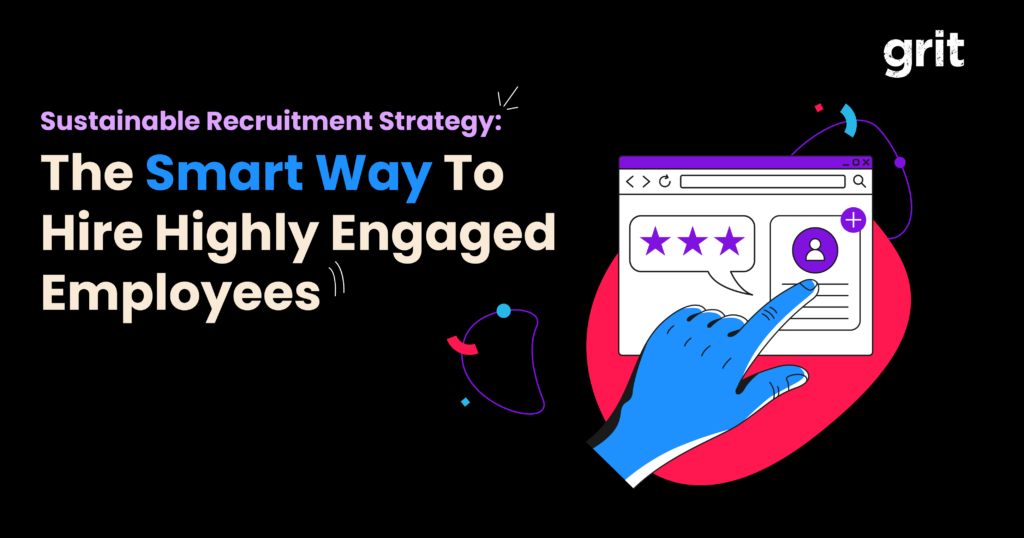
Finding the right candidates for open job positions can be a daunting task for employers. Job boards have become a popular solution to connect with potential candidates. However, not all job boards are created equal. Some job boards are more effective than others in delivering results for employers. In this article, we will explore the top job boards that work for employers and help them find the best candidates.
GRIT is a venture-backed recruitment company that provides a unique recruitment service for employers to hire qualified talent quickly and reduce the cost to hire significantly. What sets GRIT apart from other job boards is the AI-powered Talent Platform that automatically qualifies job-ready candidates in just three days for any roles specified by employers at a fixed price of US$999. Additionally, the GRIT Talent Platform integrates with some of the most common ATS, facilitates multi-user collaboration, and provides smart scheduling options for employers to arrange interviews instantly.
In other words, an employer can enjoy impressive recruitment support at a significantly low cost (US$999) to achieve a more effective and efficient hiring process. Talk to GRIT to learn more!
SEEK Asia has a wide network of regional job boards across South East Asia and Hong Kong — JobStreet MY, JobStreet PH, JobStreet SG, JobStreet ID, JobsDB HK, and JobsDB TH; reaching 36 million active talent profiles in these regions, with more than 240,000 jobs at any given time. On top of that, SEEK Asia has also been reinvesting in its products and offerings to help both employers and job seekers in matching efficiency and effectiveness.
One of the biggest investments from SEEK Asia is on their data capability and platform to help employers increase the chances of job ads reached and viewed by the matching talent by up to 20%. Simply put, employers can be sure that they will be able to recruit talent that meet their company needs and requirements easily by utilising SEEK Asia’s robust data capability and platform.
SEEK Asia offers multiple job posting packages that are tailored to meet different needs of employers. Instead of paying per job posting, employers purchase a set amount of credits that can be used to select the appropriate job posting package for their roles. This approach is particularly useful for employers to manage their budget effectively based on the urgency of their hiring needs.
| Branded | Premium | Premium Ad Plus |
| Employers get to enjoy all the benefits of Lite Ads. | Employers get to enjoy all the benefits of Branded Ads, plus. | Employers get to enjoy all the benefits of Premium Ads. |
| 2x more space for employers to showcase their top 3 value propositions. | Will be able to enjoy the ability to prioritise candidates on both mobile and desktop devices. | Employers will have access to personalised job ad writing and posting. |
| Personalised image banners. | Faster access to potential candidates. | The ability to screen and list potential candidates. |
| Wider reach. | – | Time efficiency by only interacting and engaging with potential candidates only. |
In addition to the job postings that come along in each of the ad packages, other features that further complement the job posting include:
SEEK Asia’s Talent Search has a vast database and employers can leverage this to actively search for the right candidates instead of waiting for candidates to apply for jobs. Employers will also be able to customise their search to find candidates with specific skill sets.
Using SEEK Asia’s SiVA Recruitment Centre tool, employers will be able to take advantage of its advanced filtering capabilities; they can widen or narrow their candidates to fit hiring preferences. In addition, SiVA Recruitment also allows employers to collaborate with stakeholders throughout the selection process so that they can make quicker decisions.
SEEK Asia’s Employer Branding Services help employers to stand out from their competitors by effectively expanding their company’s reach through mass media and targeted media. In addition, employers will be able to track their branding campaign; find how the job market perceives them via reviews and ratings.
Well-positioned and known within the Asia region as a comprehensive job search site. SEEK Asia provides a huge talent pool for employers to choose from — low skills, mid-level and high-end white collar. Allow employers to attract both local and global talent to work for their company. Extensive talent search features that allow employers to find the right talent.
LinkedIn is a powerful professional networking platform that provides unparalleled opportunities for connecting with like-minded businesses and expanding employers’ professional talent pool. LinkedIn boasts an impressive 900 million users across 200 countries & territories in 2023, with 13 million users in Southeast Asia and 2.77 million users in Hong Kong.
Unlike other job boards, employers will have the opportunity to connect directly with potential candidates by contacting them directly via the Linkedin direct message. This allows employers to gauge and know their potential candidates at a more personal level, not just from their resume.
In addition, employers can create a hassle-free application process using the Linkedin Easy Apply feature. And employers can share their company’s latest achievements and milestones to attract and engage candidates on the Linkedin social platform.
LinkedIn Recruiter is a premium tool offered by LinkedIn that provides advanced search and messaging capabilities for recruiters to find and connect with potential candidates on the platform. It allows recruiters to search for candidates based on various criteria such as job title, location, industry, and experience level, and provides access to in-depth candidate profiles, which include details such as work history, education, and skills.
LinkedIn Recruiter Lite, on the other hand, is a more basic version of LinkedIn Recruiter that offers a simplified search and messaging interface. It is designed for smaller companies or individual recruiters who do not need the full range of features provided by LinkedIn Recruiter. LinkedIn Recruiter Lite still provides access to candidate profiles and messaging capabilities, but with some limitations compared to the full version of LinkedIn Recruiter.
LinkedIn Jobs allows employers to post open roles and easily target, prioritise, and manage qualified candidates. LinkedIn’s algorithm helps the jobs to reach the right audiences and if that’s not enough, they also allow employers to add a budget to promote the urgent roles to increase visibility and expand reach.
LinkedIn can provide real-time insights to help employers make the right hiring decisions. In addition to that, it can also assist employers to find quality candidates effectively and address skill gap issues via benchmarking. This hiring tool also allows employers to create future talent pipelines using detailed snapshots and talent recommendations.
LinkedIn Talent Hub is a recruiting and applicant tracking system designed for companies to streamline their hiring process. It allows recruiters and hiring managers to post job openings, manage candidate applications, and collaborate with team members all in one platform. Talent Hub also offers features such as candidate sourcing, job posting distribution, and customizable hiring workflows to help companies find and hire top talent more efficiently. Additionally, the platform integrates with other LinkedIn products like LinkedIn Recruiter and LinkedIn Learning to provide recruiters with more resources and insights to make informed hiring decisions.
LinkedIn stands out from other job search sites for employers due to its focus on professional networking and comprehensive profiles. With a vast and diverse talent pool, employers can connect with potential candidates based on their skills and experience, and build meaningful relationships. LinkedIn profiles provide detailed information, allowing employers to gain a comprehensive understanding of candidates’ professional backgrounds, skills, endorsements, and recommendations.
Indeed is one of the job board pioneers that was founded in 2004. It boasts a massive 665 million visits globally monthly with 42.1 million visits from SEA and 1.6 million from HK, it also claims to have 200 million resumes worldwide — meaning employers will have access to a huge pool of candidates. For employers looking to fill non-executive roles quickly, Indeed may be an appealing option because though Indeed caters to all industries and experience levels, Indeed is mostly frequented by entry-level and lower-level professionals candidates rather than executive level candidates.
Job Postings
It comes with free job postings but with limited reach. However, employers have the option to sponsor their job ads with a dedicated budget to get more reach. It starts at $5 a day.
Indeed Resumes
Indeed Resume Search is a tool for employers to find and connect with potential job candidates on the Indeed platform. Employers can search for resumes using various criteria, view detailed candidate profiles, and save and download resumes. The tool also offers the option to contact candidates directly through the platform, and set up alerts for new resumes that match their search criteria.
Indeed Hiring Platform
The Indeed Hiring Platform is a comprehensive recruiting solution designed to help employers streamline their recruitment process. It offers features such as job posting, candidate sourcing, applicant tracking, and analytics to provide employers with a complete recruitment solution. The platform also integrates with other tools, such as Indeed Assessments and Indeed Instant Match, to help employers make data-driven hiring decisions and connect with qualified candidates quickly.
Indeed is a strong option if the location and types of jobs align with what employers need. Given employers can control the costs of their job postings via sponsoring option, making it a budget-friendly choice for employers.
Starting off as a platform to hire interns, Glints has come a long way to become a leading talent ecosystem in Southeast Asia and Taiwan. Launched in 2015 in Singapore, Glints claimed to have empowered more than 4 million talent and 50,000 organisations. Similar to Indeed, it is more commonly used by entry-level and junior-level professions but the job functions are pretty diverse, from administrative roles to engineering.
Employers will be able to enjoy the benefits of managing, tracking, and negotiating salary in one place with the Glints Recruitment tool. Through the Glints Recruitment hiring tool, employers also will be able to hire locally or remotely. The Glints Recruitment tool helps quicken the hiring process using 5 easy steps — resulting in a faster, easier and cheaper hiring process.
Glints Managed Talent is a recruitment service that helps employers find and hire top talent more efficiently. The service provides a dedicated team of recruitment specialists who work with employers to understand their hiring needs and create customized recruitment strategies to attract and identify the best candidates for their roles. Glints Managed Talent offers end-to-end recruitment services, including job posting, candidate screening, interview scheduling, and offer management. The service also provides regular updates and analytics to help employers track their recruitment progress and make data-driven decisions.
Glints Job Search is a job posting platform for employers to post job openings and connect with potential candidates. It allows employers to create job postings and specify their requirements and job details. The platform also provides features such as candidate matching, resume screening, and communication tools to help employers streamline their recruitment process. Glints Job Search offers a range of job posting options, including free and paid options, to cater to the needs of different employers.
One major factor that differentiates Glints from other job board sites is that Glints emphasised on helping job seekers excel in their career with the launch of Glints Academy, a 12-week boot camp to train and equip young professionals with skills that are much needed and in high demand within the tech industry.
Besides that, Glints also offer a full-stack recruitment model aside from the generic job posting option. Using the full-stack recruitment model option, employers get to enjoy a more cost friendly recruitment service as they are utilising their vast candidate database to support the recruitment service. This makes Glints a great choice for budget-conscious employers.
Monster was first established and launched in the US in 1994 and has since rebranded as foundit in 2022. Similar to Indeed, foundit has a massive global presence where the company has been serving more than 70 million job seekers and 10,000 customers spread across 18 countries.
Resume Database Access (RDA) allows employers to search and filter resumes based on various criteria such as experience, education, and skills. The database is regularly updated to ensure that employers have access to the most recent and relevant resumes. Additionally, the platform offers features such as resume shortlisting, communication tools, and resume tracking to help employers streamline their recruitment process.
FoundIT’s job posting provides online job posting services for regions across India, Middle East and SouthEast Asia. The platform offers various features to customise job postings and reach a wider pool of qualified candidates. The features include response management, logo with job posting, print alliance, and highlighting job postings. They are charging based on cost per job posting and they do offer a free trial for a couple of days for employers to really understand and experience foundit’s capability.
Social Job Ads from foundit is an integrated solution that maximises the reach of job postings and expands brand awareness with job seekers. It offers a potent mix of intelligent custom targeting via multi-level vehicles such as Facebook, Twitter, Instagram, Google, and foundit Database. Social Job Ads provides an exclusive, automated, and intelligent targeting solution that requires a single click for recruiters to post job vacancies. It helps reach millions of passive candidates via desktop and mobile, giving visibility to the employer’s brand on social media.
foundit Branding Solutions offers a slew of branding solutions, such as Interstitial Ads, Search Results Takeover, and Targeted Mailers. Employers will be able to promote their company brand and reach their target candidates.
foundit sets itself apart from other job board sites by having dedicated categories for skills, functions, and industries. This helps to ensure a better matching of candidates to the jobs posted by employers.
AJobThing based in Malaysia is a well-known recruitment enterprise that offers three distinctive recruitment platforms, namely Maukerja, Ricebowl, and Internsheeps in which each of the platforms serves different target audiences. Maukerja typically serves the Bahasa speaking audiences; Ricebowl serves the Chinese speaking audiences, and Internsheeps serves uni students who are looking for internship opportunities. Combined, they boast an impressive 1.5 million monthly visits. However, most of the roles offered are for non-executive and non-technical roles.
Besides the generic job posting and talent search functionality, AJobThing offers a bulk hiring recruitment solution called SHOUTOUT where it guarantees a certain number of candidates to show up for interviews.
MyCareersFuture is a government-backed job search platform in Singapore that helps job seekers find suitable employment opportunities and employers to connect with qualified candidates. What’s interesting is that advertising on the MyCareersFuture job portal is free of charge.
MyCareersFuture boasts a massive 3.5 million candidate visits monthly, meaning employers will have access to a massive talent pool every month — quickening their recruitment process and role fulfilment.
CTgoodjobs is a hiring and recruitment platform in Hong Kong; a brand extension under Career Times Online Ltd — a member of the Hong Kong Economic Times Group. CTgoodjobs offers both recruitment and employer branding solutions services to employers.
Besides the services, employers can take advantage of the huge candidate pool — over 670,000 candidates visit per month. Plus, CTgoodjobs also has a very strong social media presence on Facebook with over 328,000 followers.
CTgoodjobs provides employers with an all-in-one recruitment tool to increase the efficiency of the recruitment process, such as talent management which allows employers to screen and find candidates that match their job requirements.
In today’s competitive job market, job boards have become a crucial tool for employers in the hiring process. They provide a platform for employers to advertise their job openings and connect with potential candidates. Among the top job boards mentioned in this article, including LinkedIn, Indeed, Glints, foundit, AJobThing, and MyFutureCareersSG, employers can leverage their extensive reach and comprehensive features to effectively source and attract top talent.
These job boards offer a wide range of job opportunities across various industries, locations, and demographics, allowing employers to cast a wide net and reach a diverse pool of candidates. They also provide advanced search filters, resume databases, candidate matching, and other recruitment tools that streamline the hiring process and help employers identify the most qualified candidates efficiently. Additionally, some job boards also offer employer branding options, career advice, and networking tools that allow employers to strengthen their employer brand and engage with potential candidates.

Productivity is essential for any business to succeed in today’s fast-paced and competitive work environment, but it can be challenging to achieve high levels of productivity within the workforce. Rewards and recognition programs are a great way to build and maintain productivity while increasing employee engagement, job satisfaction, and creating a positive work culture. If you’re looking for ways to motivate and inspire your employees and create a productive work environment, recognising and rewarding workers for their hard work is one of the most effective strategies for driving productivity. In this complete guide, we’ll explore the importance of rewards and recognition, various types of rewards and recognition, how to implement them within the workplace, successful examples, and best practices to maximize their effectiveness.
In today’s competitive work environment, it’s essential to prioritize productivity for any business to thrive. However, achieving high levels of productivity within the workforce can be challenging. This is where rewards and recognition come into play. By acknowledging and celebrating the hard work and achievements of employees, employers can boost morale, increase motivation, and ultimately inspire employees to do their best work. Investing in rewards and recognition can lead to higher levels of employee engagement, retention, and overall success for the company.
Rewards are tangible or intangible items given to employees for achieving specific goals, while recognition is simply acknowledging an individual’s hard work or exceptional contribution to the organisation. Both rewards and recognition have numerous benefits, including improved motivation, job satisfaction, and increased productivity. So, if you’re looking for ways to motivate and inspire your employees and create a productive work environment, investing in rewards and recognition is a great place to start.
Creating a culture that fosters employee engagement and satisfaction is crucial in today’s fast-paced work environment. One effective way to achieve this is by implementing a rewards and recognition program. By acknowledging and celebrating employees’ contributions and accomplishments, you can create a positive work atmosphere that inspires and motivates your team. Rewards and recognition not only boost morale but also drive employee retention, increase productivity, and strengthen overall performance, benefitting both employers and employees. Building a culture that values and acknowledges the efforts of team members is a win-win situation. With rewards and recognition, you can attract top talent and keep them happy and motivated in a workplace that promotes their value.
While the concept of building rewards & recognition programs may seem simple, the type of rewards and recognition offered can vary greatly from company to company. Let’s take a closer look at the different types of rewards and recognition programs available and how they can benefit your organisation. From monetary incentives to professional development opportunities, there are a variety of ways to acknowledge and celebrate your team’s hard work and achievements. So, let’s dive in and explore the various options available to build a culture of appreciation and engagement in your workplace.
Employee recognition is an essential aspect of fostering a positive and productive work environment, and many companies in the Asia-Pacific (APAC) region are leading the way in this regard. Here are some examples of APAC companies that have implemented innovative and effective rewards and recognition programs, and have reaped the benefits of a motivated and engaged workforce.
To identify when to reward employees, you should have a clear understanding of what success looks like for your team and what behaviours or achievements are most valued by your organisation. This can involve setting clear goals and performance metrics, as well as tracking progress toward those goals.
When you see employees going above and beyond their normal duties, achieving significant milestones, or consistently meeting or exceeding performance targets, these can be excellent opportunities to recognize and reward their efforts. It’s important to make sure that rewards are timely and relevant, so that employees feel recognized and appreciated for their hard work and dedication.
You can also create a culture of recognition by encouraging managers and team members to regularly recognise each other’s accomplishments and contributions. This can help to create a positive feedback loop that reinforces desired behaviours and motivates employees to continue performing at their best.
Rewards and recognition programs are only as effective as the participation and engagement of your employees. To inspire your team to get involved, it’s important to get creative and find strategies that go beyond the standard rewards. Here are some strategies to encourage employee participation in rewards and recognition programs:
In conclusion, rewards and recognition programs are essential for building and maintaining productivity in the workplace. By acknowledging and celebrating employees’ hard work and achievements, employers can boost morale, increase motivation, and ultimately inspire employees to do their best work. Rewards and recognition not only benefit the employees but also drive employee retention, increase productivity, and strengthen overall performance, benefiting the company as a whole. By implementing a culture of recognition, employers can create a positive work environment that inspires and motivates their team, attracting top talent and keeping them happy and motivated in a workplace that promotes their value. With the various types of rewards and recognition programs available, employers can tailor their approach to fit the unique needs and goals of their organisation, ultimately maximising their effectiveness.

The Society for Human Resource Management (SHRM) acknowledges that behavioural interview questions are an effective interview technique that can be used across different types of companies. These questions are a crucial part of the hiring process, as they help evaluate a candidate’s work experience and work style.
Now, this standardised set of questions allows interviewers to compare and assess multiple candidates applying for the same job opening in a structured manner. Behavioural interviews aren’t technical at all, and are focused on the candidate, making it possible for them to prepare well in advance.
Of course, you’ve got several interview strategies and question types available for you to assess candidate readiness and suitability, but behavioural-based questions remain one of the best methods for finding out how the candidate is able to handle different work situations (sometimes on the spur of the moment)!
Behavioural-based questions are interview questions that are designed to elicit information about a candidate’s past behaviours in specific situations, as a good way of predicting their future performance. Instead of hypothetical or theoretical questions, these questions ask the candidate to describe real-life experiences in detail, and how they handled each one of them.
By asking questions about how a candidate has handled specific situations in the past, employers can get a sense of how they might handle similar situations in the future. These challenging questions typically focus on skills and qualities that are important for the job, such as problem-solving, teamwork, creative thinking, communication, adaptability, and leadership.
For example, instead of asking a candidate how they would handle a difficult customer, a behavioural-based interview question might ask them to describe a time when they had to deal with a difficult customer in the past, and how they kept on top of the situation.
Sample questions about teamwork
Sample questions about adaptability
Sample questions about time management
Sample questions about communication
Sample questions about leadership
Sample questions about personal stress
Do keep in mind that the candidates’ answers to behavioural-based interview questions should last between one and two minutes on average, with factual answers being even shorter. The answers are meant to help you see how efficiently a candidate can think on their feet (not tell their entire life story!), as opposed to relying solely on their accomplishments listed on paper.
If you’re in employer branding, it’s also important to use behavioural questions to identify the kind of people who are most likely to excel in the role. Above all, remember that this isn’t meant to be a new form of torture for the candidates, your goal is to learn as much as you can about them in a short timeframe, and how they may (or may not) complement the current team.

Gone are the days when employers could post a single job ad, and expect a flood of qualified applicants to come pouring in! The job market has become increasingly competitive, with job seekers having more options than ever before. As a result, employers are struggling to find the right people to support their business goals.
Traditional hiring methods, such as posting ads on multiple job boards or relying on resumes and cover letters, are no longer sufficient. To succeed in today’s fast-paced and dynamic environment, employers need to adopt sustainable recruitment strategies that go beyond just filling open positions. This requires a shift in mindset from the conventional approach of hiring for skills and qualifications, to hiring for values and cultural fit.
By doing so, they can develop a steady pipeline of top talent who are not only skilled and knowledgeable, but are also highly engaged and committed to the company’s success. In addition, this method can help to reduce turnover rates, which can be a significant cost to companies. When employees are engaged and satisfied with their work, they are more likely to stay with the company for the long term. This reduces the need for constant hiring and training, which can be time-consuming and expensive.
In addition, sustainable recruitment strategies can help to improve the employer brand. When companies focus on creating a positive candidate experience and building a culture that fosters employee engagement and satisfaction, they become known as an employer of choice. This can help to attract top talent, and improve the company’s reputation in the industry.
In fact, the statistics on sustainable recruitment speak for themselves. According to a report by LinkedIn, 75% of talent acquisition leaders believe that employer branding has a significant impact on their ability to hire great talent. Furthermore, companies with strong employer brands see a 43% reduction in cost per hire and a 28% reduction in turnover rates. In another report, it was found that 69% of job seekers would not take a job with a company that had a bad reputation, even if they were unemployed.
It’s evident how essential it is for your company to have a solid sustainable recruitment strategy in place, which is why we’ve come up with this comprehensive guidebook, so you can hire effectively especially in this challenging recruitment market! Download the comprehensive ebook now!

During the interviewing process, as a recruiter or HR representative, you’ll encounter various interview styles and questions. Your objective should be to identify candidates who meet the position’s criteria, and can positively contribute to the company culture. If you’re at a loss as to how to do so effectively, utilising competency-based interview questions is an effective way to identify such candidates. These prompts would allow you to quickly determine how the talent in front of you would handle a certain situation, and their response in different scenarios.
These are also known as a structured, behavioural, or situational interview. They’re designed to assess a candidate’s skills, knowledge, and abilities required to perform the job effectively. Unlike traditional interview questions, which focus on past experiences and qualifications, this type asks candidates to provide examples of how they have demonstrated certain competencies or skills in the past.
The questions are often structured around specific competencies, such as problem-solving, communication, leadership, teamwork, time management, or adaptability, among others. The interviewer will ask the candidate to provide examples of how they’ve demonstrated any of those in their past work experience, education, or personal life. Competency-based questions aid in determining how a candidate will utilise the skills and experience they have acquired in their professional life to benefit your company.
This type of training typically covers a range of topics, including identifying core competencies required for a particular job, designing interview questions that assess these competencies, and evaluating candidate responses.
The goal of a competency-based interview training is to help recruiters and HR representatives improve their ability to identify the best candidates for a particular role based on their competencies, rather than just their experience or qualifications. Here’s how you can ensure your recruiters or HR representatives are trained to ask the right questions:


When responding to competency interview questions, job seekers should provide examples from their real-life experiences, specifically those that demonstrate the competencies highlighted in the question. The structure of their response is also important, and should follow the STAR method:
This approach offers insight into the candidate’s work approach, problem-solving skills, and ability to communicate effectively under pressure. Employers should look for candidates who can structure their answers in this way, indicating that they are well-prepared for the interview, as well as possess the ability to think critically and coherently even in high-pressure situations.
However, the risk with this approach is that candidates may prepare rehearsed answers based on the job description, potentially providing less insight into their problem-solving abilities in spontaneous situations.
Interviewing candidates nowadays can present unique challenges, because they now have access to a wide range of resources on what are the techniques used, and the types of questions that recruiters and hiring representatives may ask.
Nevertheless, using this type of questions will provide you with a clear indication of the skills and characteristics of your potential employee, regardless of how well they perform in interviews. By asking the right competency-based questions, you can immediately observe how the candidate would handle work-related situations, removing some of the uncertainty about whether the role is a good fit for them. Good luck!

Have you ever wondered how you can avoid wasting precious time and resources on unqualified candidates (or even those who display red flags)? One way is to remember that it’s essential to conduct a pre-qualification or pre-screening process before proceeding to the interview stage.
This process ensures that applicants meet the minimum requirements for the position and have the necessary skills. Incorporating pre-screening interviews into your hiring process can significantly benefit your company, as it helps filter out unsuitable candidates and saves you from the potentially expensive mistake of making a wrong hire.
A pre-screening interview, also known as a pre-employment screening, is a preliminary method conducted by employers to assess whether a job candidate meets the basic requirements for the position before inviting them for an in-person interview. It’s typically conducted over the phone or via video conferencing.
The primary purpose of this is to narrow down the pool of candidates for a position, by eliminating unqualified applicants early in the hiring process. During a pre-screening interview, the recruiter or HR representative asks questions related to the candidate’s qualifications, experience, and job requirements. Based on the responses, the employer can then determine if the candidate is a good fit for the position and the company.
It can also be a valuable step in helping employers identify if a candidate has embellished the resume. For example, if they make it seem as though they’re more skilled than they actually are, have a sketchy employment history, lack the necessary qualifications, or are unwilling to answer questions, the employer can quickly eliminate them from the applicant pool.
That’s why pre-employment assessments are becoming increasingly popular, which is most likely due to their effectiveness. According to a Bersin by Deloitte’s research, it was revealed that pre-employment assessments are a USD1 billion industry, and more than 60% of large companies use them regularly as part of their recruitment process.
Conducting a pre-screening interview is an essential part of the hiring process for any company, as it not only helps filter out unqualified or unsuitable candidates, it’s crucial in helping to reduce the time-to-hire (TTH). The TTH is how long a company needs to fill a vacant position, which includes the duration from when the job vacancy is advertised to the point when an offer is made. Here are the steps to conducting a pre-screening interview:

Don’t forget to approach each session with a willingness to consider the candidates’ responses carefully. Although some pre-screening questions may elicit similar answers, place more emphasis on applicants who display innovativeness and strong communication skills. Furthermore, keep to your interview schedule by reserving the more comprehensive questions for face-to-face assessments.
Pre-screening interviews consist of brief interview questions that aim to evaluate if potential candidates meet the qualifications for an open position. But don’t forget to keep an eye out for certain red flags along the way too, like those who seem distracted and unprepared for the interview, are mainly focused on salary expectations, or even just flat-out avoiding some of your questions! We hope these concise questions help you to narrow down the pool of candidates to the most qualified ones, as well as help you in saving time and resources during the hiring process.
Join over 500 companies that are hiring (effectively and efficiently) with GRIT!

In today’s digital age, software engineering has become an integral part of many industries and companies. For example, the U.S. Bureau of Labor Statistics has found that software developers are expected to see the third-largest increase in jobs of any occupation over the 2021-31 decade.
As a result, recruiters and HR managers are often tasked with finding and hiring skilled software engineers to fill critical roles within their companies. However, that field is complex and constantly evolving, with a wide range of technical terms and jargon that may be unfamiliar to those outside of the industry.
By familiarising themselves with software engineering concepts and terminology, recruiters and HR managers can more effectively navigate the ever-changing landscape of software engineering, properly identify and evaluate suitably skilled candidates who can drive success for the business.

It’s no secret that the job market is still largely dominated by males, as evidenced by employee diversity data from the Fortune 500 companies (which make up about 2/3 of the US economy). According to Deloitte, only 27% of Fortune 500 board members are women (including both white and minority women). And only one in six of the Fortune 500 publish annual DE&I reports to commit to progress, and to hold themselves publicly accountable.
While there’s no single reason why this imbalance continues to exist, one factor is clearly present: The language used on job descriptions tends to appeal more to men than women. So what can be done about this problem? Well, one great way would be to stop using gendered language altogether! And even though we’re not saying you should never use pronouns like “she” or “he”, it’s important to consider how your job description might read differently depending on who you’re trying to attract as candidates.
The method above can be classified as being inclusive, a term that’s actually a buzzword which has been around for a while, but its meaning has evolved over time. In the past few years, it’s become synonymous with being open-minded and accepting of others, including those who are different from you.
In today’s modern workplace, it can be difficult to find ways to incorporate this type of thinking into your hiring process – especially since most job descriptions are so rigidly structured around specific requirements (and even then, those requirements may not always be met). When you’re writing a job description, it’s important to remember that your goal is to attract candidates with diverse backgrounds and experiences. A well-written job description will help you do this by focusing on the skills and abilities needed for the position, and there are ways to make sure that your job ads are truly inclusive, which we’ve covered the top tips for you below.
As we’ve mentioned above, choosing to use words that can be interpreted as gender-neutral language in your descriptions is a surefire way to ensure that you’re creating an inclusive environment. Additionally, you’d be able to reach a broader and more balanced selection of applicants, as proven by studies which found that job ads with gender neutral terms see an increase in the likelihood of hiring more diverse teams, up to 46% when hiring women.
As such, avoid using gender-specific pronouns, like the conventional “he” or she”. Instead, use words like “they”, or make sure all jobs are open to applicants of any gender by using “and/or” when listing qualifications or requirements for the position. You can even word your job ads to sound like they’re speaking directly to the candidate.
Instead of writing “He will design, code, test, and implement our solutions” for the position of a Software Engineer, putting “You will design, code, text, and implement our solutions” ensures that jobseekers don’t get the impression that the role is geared towards males only.
You can also choose to use gender-neutral job titles to entice candidates to click in and read the rest of your job posting. Try substituting words like “fireman”, “foreman”, and “Chairman” with words like “firefighter”, “supervisor/manager”, and “Chairperson”.

It may seem obvious that you should steer clear of any form of bias when creating an inclusive job ad. However, it’s easy to fall into this trap unknowingly, since any one of them can be unconsciously implied when creating a list of qualifications based on previous experience working in similar industries.
Take, for example, racial bias that refers to a set of attitudes or beliefs that one race is superior or inferior to another. It can appear in formerly-popular phrases like “blacklist” (defined as a collection of entities that are blocked from communicating with or logging into a computer, site, or network), “brown bag session/lunch” (referring to informal business meetings or training sessions usually held in an office setting during lunchtime), and “cakewalk” (which means a surprisingly easy task). They’re now being replaced with words like “reject/block list”, “lunch and learn”, and “walk in the park”, respectively.
Whereas for an affinity bias, it comes to light when a recruiter or hiring manager creates a job description that favours a particular group of job seekers, simply because they have a similar background. This can be anything from the candidate’s grade point average (GPA), to the tertiary education institution or club membership. Here’s an example of a GPA bias in a job description for an intern in Cybersecurity, which isn’t an accurate measure of someone’s knowledge: “Junior or senior level student currently enrolled in an accredited college or university, must have at least a 3.0 GPA”.
Finally, in today’s rapidly digitalising world, the demand for “digital natives” (a term which may limit or exclude applicants who weren’t born into the age of the internet) is seeing an uptick as well. It’s why recruiters and hiring managers should recognise the experience bias and ageism in job descriptions, when and if they do occur. You can replace it with an inclusive alternative, choosing to rework the sentence to refer to the actual requirement, in a way that doesn’t imply that the ideal candidate should be under 30 years of age. For example, “Bonus points if you have technology skills or knowledge in social media”.
When writing a job description, it’s important to be clear about what you’re looking for. The best way to do this is by emphasising that you’re looking for more than just a candidate; you want the right person who will fit into your team, gel well with the company culture, and contribute positively from day one.
Refrain from having the outdated mindset that there’s a “perfect” candidate for every role, as this will not only disregard the individual’s ability to learn new skills and adopt knowledge as they go along, it also hints that the person will not be able to adapt to a new environment. Rather, understand that whatever skills or “must-haves” you choose to list in the job description are able to be picked up while the candidate is in the role. But, if you’d still like to highlight certain essential skills, you can soften the sentence with language like “familiarity with”, “bonus points for”, or “if you have any combination of these”.
In the case of inclusivity, focusing too heavily on requirements or necessary skills/experience can alienate top candidates. In fact, research has shown that women feel they need to meet 100% of the listed job requirements before applying, while men often have no qualms in submitting their applications after meeting only 60% of the requirements.

When writing job descriptions, it’s important to use the right language that reflects the type of candidates you want to see apply for the role. Firstly, your choice of words might cause candidates to experience a lack of confidence in applying, due to the intimidating language or ambiguity surrounding the job requirements.
For example, by using adjectives such as ‘energetic’, ‘fast-paced’, or ‘110% commitment’, it may suggest that your company is seeking a young employee with fewer obligations who can work extended hours. This could potentially indicate a lack of consideration for individuals with families, or a disregard for a healthy work-life balance. To promote inclusivity, your job description should cater to individuals of all ages, marital statuses, and parental backgrounds.
It’s also important to avoid using buzzwords and jargon when coming up with a job description. In an online discussion exercise by Rutgers University to find out primary concerns regarding job descriptions, more than 60% of the respondents cited vagueness as their top issue when reviewing job postings.
Some participants felt that job descriptions contained an excessive amount of detail, especially those filled with company jargon and buzzwords, which detracted from the personal aspect of the application process. Examples of jargon, buzzwords, and cliches include terms like ‘ninja’, ‘guru’, ‘rockstar’, ‘game changer’, ‘self-starter’, ‘wizard’, ‘disruptor’, and ‘hacker’.
It’s true that most industries possess their own unique terminologies, which experienced employees learn through on-the-job experience. However, job descriptions that are laden with corporate language can actually be one of the biggest barriers and discourage talented prospective applicants, particularly recent graduates or those who are re-entering the workforce or switching careers. As such, aim for more universal wording, like “pays attention to details” or “personable with customers”.
To attract qualified and talented disabled workers, job descriptions should mention reasonable accommodations, such as flexible hours or telework policies. Avoid using language in the description that could discourage job seekers with disabilities from applying, and clearly state how disability is supported in the workplace.
Remember, it’s important to focus on how a requirement needs to be accomplished, rather than simply what needs to be done. For instance, a job that requires constant movement throughout an office shouldn’t be limited to ‘walking’, since that would exclude someone who uses a wheelchair. The job description should convey that the workplace welcomes and values all candidates, with phrasing such as “ability to complete tasks with or without reasonable accommodations”. Additionally, instead of writing “access to your own vehicle isn’t always necessary”, the description should state “access to reliable transportation”, which is more inclusive to people with disabilities.
Refer to the chart below by Monster, which shows that the removal of “how” a requirement is met (i.e. the “how this is accomplished”) in favour of stating what needs to be accomplished can make a significant difference:
| Discriminatory Language | More Inclusive Language |
| Must be able to lift 50 pounds | Moves equipment weighing up to 50 pounds |
| Seeking able-bodied individual | [No replacement. Avoid it completely.] |
| Bending and crouching under desks to install equipment | Positions self to install equipment, including under desks |
| Must be able to stand for entire shift | Must be able to remain in a stationary position during shift |
| Talks to students about their financial concerns | Communicates with students about their financial concerns |
| Walks throughout the building to access files | Moves throughout the building to access files |
| This role requires visually inspecting sites for safety | This role requires inspection of sites to detect safety concerns |

If your company is actively working to create a more welcoming and non-discriminatory workplace, it’s worth mentioning this in your job descriptions. This will make it clear that your company is an Equal Opportunity Employer, dedicated to fostering a diverse and inclusive culture, and committed to avoiding discrimination against candidates and employees based on protected characteristics such as:
You might also want to mention specific inclusion-related initiatives your company has undertaken, such as employee resource groups or mentorship programmes for women and people of colour. Including a simple invitation for underrepresented groups to apply, or requesting applicants to let you know if they require accommodations, can be particularly impactful.
In fact, research has shown that inclusive job descriptions that go beyond the standard equal opportunity statement will be able to fill their open positions, on average, 10% faster across all demographic groups than those that do not. However, it’s important to ensure that your job description’s language consistently aligns with your commitment to inclusion. Candidates will only believe your company is inclusive if your job description reflects this through its tone and phrasing.
Here’s a good sample from Johnson & Johnson, who their own comprehensive DEI (Diversity, Equity, and Inclusion) policy:
| Our Vision Be yourself, change the world. Our vision at Johnson & Johnson is for every person to use their unique experiences and backgrounds together – to spark solutions that create a better, healthier world. |
| Our Mission Make diversity, equity, and inclusion how we work every day. Our mission is to make diversity, equity, and inclusion our way of doing business. We will advance our culture of belonging where open hearts and minds combine to unleash the potential of the brilliant mix of people in every corner of Johnson & Johnson. We will create equity by tailoring tools and resources to meet individual needs, and by continuously improving our systems and processes so everyone has the opportunity to reach their full potential. |

Your company’s culture is your brand. And, if you want to attract and retain the best talent, you need to create a culture that supports diversity and inclusion. You can do this by creating a workplace where everyone feels comfortable being themselves, and has equal access to opportunities. To ensure you start on the right foot, it’s important to pay attention to the job descriptions to ensure they’re inclusive and appeal to underrepresented candidates, by constantly evolving and improving them.
One way to do this is by sending drafts of the job description to underrepresented talent on the teams you’re hiring for, and asking for their suggestions. Ask them if the job description would give them the impression that they’d be welcome on their own team. However, it’s important to be clear that this is only if they’re willing to give feedback, because overburdening employees who are underrepresented can go against the entire diversity initiative.
By taking note of these elements and incorporating them into other job descriptions, you can better attract underrepresented candidates, and help them feel welcome in your company. This ongoing process of seeking feedback and making changes will help ensure that your job descriptions are effective in attracting a diverse range of candidates. It also makes your company more attractive to employees, who are more likely to stay in their positions if they feel their identity is valued and respected by their employer.
In the end, inclusive job descriptions are not only good for business, but also a great way to attract a diverse pool of applicants, and ensure that you’re hiring the right person for the role. Case in point is a LinkedIn report which found that women are proven to be more selective when they apply for jobs. They tend to screen themselves out of the conversation, and submit fewer job applications than men. And yet, studies have highlighted the positive impact of employing women, particularly for leadership positions, on the success of businesses. For instance, companies in California with the highest percentage of women executives and board members had significantly higher median returns on assets and equity, at least 74% higher than among the overall group.
Thus, by making sure that you use the right language and carefully choosing the words, you can show how much your company values diversity. Inclusive job descriptions will also help promote an environment where candidates from all backgrounds feel comfortable applying for positions at your company – which means more people from underrepresented groups will have access to opportunities they otherwise wouldn’t have had!

What are some of the indicators of a successful candidate experience? Consistent communication that focuses on quality, is one. In a study that looked at the recruiter-candidate experience, it was found that 47% of the talent who were surveyed said that “great communication, including prompt feedback and follow-ups” made for a positive candidate experience.
While it’s easier to use methods like phone calls, text apps, or in-person meetings to keep in contact with candidates – especially those you’re interested in – there’s also emails to consider. But, there’s an art to using email, especially if you want to come across as clear and concise; there’s nothing worse than a recruiter blasting out emails which are long-winded and irrelevant.
In fact, a survey found that a large number of jobseekers would be more willing to take positive action if they had a clear and consistent hiring process – 80% would apply to the company again, 78% would accept the job offer, while 60% would tell others to apply to the company. Using templates ensures that all candidates receive the same information, and are treated in a consistent manner, which can help build a positive candidate experience and improve the reputation of the company.
That’s why we’ve assembled a list of the 25 most popular email templates for you to refer and use, so that you can continue to consistently reach out to top talent, keeping you ahead of your competitors.
By following these tips, recruiters can quickly write clear and concise emails that not only effectively communicate the message, it’ll encourage the candidate to take action.
A clear and descriptive subject line will help the email stand out in the candidate’s inbox and give them a quick understanding of what the email is about. This is particularly important in a busy inbox, as it can help ensure the candidate opens and reads the email. The subject line should be short, to the point, and accurately reflect the content of the email.
Personalising the email by using the candidate’s name and mentioning specific details about their background or qualifications shows that you have taken the time to review their information and make a personalised connection. This can help establish a positive relationship with the candidate and improve their impression of the company.

A lengthy introduction or elaborate explanation is unlikely to hold the candidate’s attention, so it’s important to get straight to the purpose of the email. State the main message and the desired outcome clearly and concisely, using simple and easy-to-understand language.
Explain why the candidate should be interested in the opportunity and what sets your company apart from others. This could include details about company culture, benefits, or opportunities for growth and development. Highlighting the benefits can help motivate the candidate to take action and show interest in the opportunity.
Let the candidate know what the next steps are and what you expect from them. This could be scheduling a call, sending over additional information, or completing an application. By including a clear call-to-action, you can help the candidate understand what is expected of them and make it easier for them to take action.
Before sending the email, take the time to double-check for grammatical errors, spelling mistakes, and clarity. A well-written and professional email will help establish a positive first impression and maintain a level of professionalism throughout the recruitment process.
Use a professional tone throughout the email to maintain a level of professionalism, but it’s best to also remain approachable in order to establish a positive first impression. This can include avoiding overly casual language, abbreviations, and emoticons. A professional tone can help communicate the level of importance the company places on the recruitment process and the opportunity being offered.

Using email templates can save recruiters a significant amount of time. The average professional spends more than 5 hours of their work day reading and answering emails, according to a survey by Adobe. By using templates, recruiters can reduce the time spent crafting each individual email, allowing them to focus on other tasks and increase their overall productivity.
Consistent messaging and tone can help create a more positive candidate experience. Research has shown that a whopping amount of job seekers (81%) prefer employers who have a clear and consistent communication process, as it would greatly improve their overall experience as well as allow them to have a more positive view of the company. Using templates ensures that all candidates receive the same information and are treated in a consistent manner, which can help build a positive candidate experience and improve the reputation of the company.
As the number of candidates being considered increases, it becomes more difficult to manage the volume of emails being sent. Templates can help automate the recruitment process, enabling recruiters to handle a larger volume of candidates more efficiently. This can be particularly important for companies that are growing rapidly or that have a high volume of recruitment needs.
Email templates can be tailored to fit the specific needs of each role or company. For example, a template for a technical role might include information about the specific technology stack the company is using, while a template for a sales role might include information about the company’s sales process. By customising templates, recruiters can ensure that the right information is being communicated to the candidate and that the recruitment process is tailored to the specific needs of the company.
The candidate experience is important, and that’s not only because 65% of candidates say a bad interview experience makes them lose interest in the job. It’s also a major component of employer branding: How companies treat their employees can define their brand and reputation for years to come. Who wouldn’t want to streamline the entire recruitment process so that it not only saves time and ensures the company’s brand consistency, it also improves the candidate experience and minimises disruption? They’re so easy for anyone from companies of all sizes to adopt, so it’s time for recruiters to start using email templates and enjoy these benefits!

Where companies once used traditional methods of executing everything manually, their human resources (HR) personnel were bogged down with hours of tedious but essential admin work. These processes can be time-consuming, cumbersome, and laborious because they’re all compliance-driven.
Now, with the premium on top talent in today’s highly competitive job market, HR has moved from a backend administration role to a frontline strategic function. Which can only mean one thing: A greater pressure on them to perform well in their employee management and candidate experience.
Enter HR tools, which are the wide range of technological solutions that help companies manage their day-to-day HR activities effectively, while also achieving improved efficiency. In a survey carried out to determine the opportunities present for HR tech to grow, it was found that 58% of HR professionals used three or less tech tools.
So, while it’s true that HR teams now utilise some of the more common tools in their day-to-day tasks, there’s still plenty of room for further adoption. Let’s face it, without them, your company will be lagging, and that’s going to cost you when it comes to attracting and retaining the best talent.
Without further ado, let’s take a closer look at some of the essential HR tools that your company should be implementing in 2023, and beyond!

The HRIS is essentially a software solution that’s used to collect, store, manage, and process data on a company’s employees, as well as its policies and procedures. As a software that performs various functions in order to streamline and support HR tasks, as well as help manage their processes, here are some of its everyday uses:
A HRIS is important for companies because it provides several benefits, such as:
| Recommended Human Resources Information Systems | Price |
| 1) Workday | Prefers to deal with each company directly to give a tailored quote for their needs. However, some reports have mentioned that pricing usually starts at USD99 per user/month. |
| 2) SAP SuccessFactors | Tiered pricing for annual subscriptions starts at USD85 per employee for companies with up to 100 employees (about USD8 per employee/month), and drops from there depending upon the size of the user base. |
| 3) ADP Workforce Now | Prefers to deal with each company directly to give a tailored quote for their needs. However, some reports have mentioned that pricing usually starts at USD62/month, though the average business should expect to spend a lot more than that. |
| 4) Oracle HCM Cloud | Consists of three pricing editions; Help Desk (USD4 per employee/month), Talent Management (USD10 per employee/month), and Global HR (USD15 per employee/month). |
| 5) UKG Pro | Prefers to deal with each company directly to give a tailored quote for their needs. However, some reports have mentioned that pricing usually starts from USD600 per year for every five users. |

Employee Onboarding software is a tool that automates and streamlines the process of introducing new hires to a company, covering tasks such as orientation, paperwork, and training. This is to help new hires get up to speed quickly and efficiently, improving their overall experience and reducing the time it takes to become fully productive. Some of the functions include:
An Employee Onboarding software is important because of several benefits, including:
| Recommended Employee Onboarding Softwares | Price |
| 1) BambooHR | BambooHR charges on a monthly or quarterly subscription basis, costing between USD6 and USD12 per employee/month. As a company’s employee count rises, BambooHR pricing will decrease with volume. |
| 2) Lever | Prefers to deal with each company directly to give a tailored quote for their needs. However, some reports have mentioned that pricing usually starts from USD300 a month for a company of up to 10 people. |
| 3) JazzHR | Consists of three pricing editions; Hero at USD49/month (when billed annually), Plus at USD239/month (on an annual plan), and Pro at USD359/month (on an annual plan). |
| 4) iCIMS | Pricing is based on the number of users, number of products, and integration with any iCIMS partners, where the paid version starts at USD1,700/month. |
| 5) Workable | Consists of three pricing editions; Paygo at USD129/month (pay per job), Standard at USD299/month (pay upfront, commit annually), and Premier at USD599/month ((pay upfront, commit annually). |

A Performance Management System supports companies in evaluating and managing performance appraisal, goal setting, feedback, and continuous performance tracking. Companies are thus able to improve performance, align employee goals with business objectives, and make data-driven decisions about employee development and compensation. This software can perform the following functions:
Companies should consider a Performance Management System because of benefits like:
| Recommended Performance Management System | Price |
| 1) 15Five | Consists of four pricing editions; Engage at USD4 per user/month (billed annually), Perform at USD8 per user/month (billed annually), Focus at USD8 per user/month (billed annually), and Total Platform at USD14 per user/month (billed annually). |
| 2) JazzHR | Consists of three pricing editions; Hero at USD49/month (when billed annually), Plus at USD239/month (on an annual plan), and Pro at USD359/month (on an annual plan). |
| 3) Reflektive | Costs USD7,500 flat rate, and is a subscription-based software package. |
| 4) Lattice | Consists of a main pricing edition with optional add-ons; Performance Management + OKRs & Goals (USD11 per person/month), Engagement (additional USD$4 person/month), Grow (additional USD4 person/month), and Compensation (additional USD6 person/month). |
| 5) Culture Amp | Consists of three pricing editions; Engage (from USD5 per person/month), Perform (from USD11 per person/month), and Develop (from USD4 per person/month). |

This software is a tool that enables companies to track, manage, and report on employee time and attendance. It automates the process of recording employee hours, making it easier for companies to ensure compliance with labour laws. Furthermore, it improves accuracy, reduces administrative burden, and provides valuable insights into workforce utilisation. The following are just some of its functions:
This software is able to provide companies with several benefits, such as:
| Recommended Time And Attendance Tracking Softwares | Price |
| 1) QuickBooks | Consists of four pricing editions; Simple Start (USD15/month), Essentials (USD27.50/month), Plus (USD42.50/month), Advanced (USD100/month). |
| 2) When I Work | Consists of two pricing editions; Standard (USD2.50 per user/month), and Advanced (USD6.00 per user/month), with optional add-ons available for both plans. |
| 3) Homebase | Price: Consists of three pricing editions; Essentials (USD20 per location/month), Plus (USD48 per location/month), and All In One (USD80 per location/month). |
| 4) Deputy | Price: Consists of three pricing editions; Scheduling (USD3.50 per user/month billed monthly), Time & Attendance (USD3.50 per user/month billed monthly), and Premium (USD4.90 per user/month billed monthly). |
| 5) Bitrix24 | Price: Consists of four pricing editions; Basic at USD61/month (five users), Standard at USD124/month (50 users), Professional at USD249/month (100 users), and Enterprise from USD499/month (from 250 users). |

This is a tool that automates the administration and management of employee benefits programmes, by streamlining the process of enrolling in and managing benefits, thus simplifying the process for both employees and HR teams. The goal is to reduce administrative burden, improve the accuracy of benefits data, and enhance the employee experience. Here are just some of the functions to expect:
It’s important for companies to consider this software because it provides several benefits, including:
| Recommended Employee Benefits Management Systems | Price |
| 1) Zenefits | Price: Starting off with a base plan at USD10 per employee/month, companies can choose to add-on further features which is the Growth plan at USD20 per employee/month or the Zen plan at USD27 per employee/month. |
| 2) Gusto | Price: Consists of three pricing editions; Simple at USD40/month (plus USD6 per person/month), Plus at USD60/month (plus USD9 per person/month), and Premium which is tailored to each company’s individual needs. |
| 3) Benefitfocus | Price: Costs USD2-USD4 per user/month, depending on whether you get the base features or the full product stack. |
| 4) ADP TotalSource | Price: Prefers to deal with each company directly to give a tailored quote for their needs. However, some reports have mentioned that pricing usually starts at around USD85 per employee. |
| 5) Paychex Flex | Price: The introductory plan (Paychex Flex Essentials) costs USD39/month plus USD5 per employee. |

A Learning Management System (LMS) is a software application that facilitates the administration, delivery, and tracking of educational courses or training programmes. It provides an efficient and effective way to manage and deliver learning content as well as track employee progress and achievement. This software can perform the following functions:
It’s important for your company to consider this software for its benefits like:
| Recommended Learning Management Systems | Price |
| 1) TalentLMS | Consists of four pricing editions; Starter at USD69/month (billed yearly), Basic at USD149/month (billed yearly), Plus at USD279/month (billed yearly), and Premium at USD459/month (billed yearly). |
| 2) Docebo | Two types of flexible plans available – Growth and Enterprise – with a subscription-based pricing model that’s based on the number of active users per month. |
| 3) Talent LMS | Consists of five pricing editions; Starter at USD69/month (billed yearly, up to 40 users), Basic at USD149/month (billed yearly, up to 100 users), Plus at USD279/month (billed yearly, up to 500 users), Premium at USD459/month (billed yearly, up to 1,000 users), and Enterprise which requires a custom pricing but allows for more than 1,000 users. |
| 4) SAP Litmos | Starts from USD6 per user/month (for 150 to 500 active learners), the SAP Litmos Pro subscription needs at least 150 active learners. Larger companies get a better deal (for 501 to 1,000 active learners) since the cost is USD4 per user/month. |
| 5) Absorb LMS | Small businesses can purchase an Absorb LMS licensing fee for USD800/month plus a 12-month user fee of USD16 per active user. Hosted pricing starts at USD1,350/month (or USD14,500/year) for up to 500 users. It’s USD4,850 per month (or USD52,380 per year) for up to 5,000 users, and USD8,850 per month (or USD95,580 per year) for up to 17,500. |
HR teams face the increasingly difficult challenge of attracting top talent to their companies, and retaining current employees. This involves understanding the current job market and competition for talent, as well as developing the necessary strategies to attract and retain employees. Additionally, they’d also need to ensure that employees are engaged and satisfied with their work, which is essential for improving productivity and reducing turnover. This involves regularly surveying employees to gauge their satisfaction, including helping employees grow and develop in their careers.
What better way to do all of the above than to start adopting HR tech in order to help your HR team automate previously-tedious processes as much as possible, including using data to take advantage of better people skills. If you’re looking for that edge above your competitors, this list of must-have tools will allow a crucial shift of your HR’s focus from administrative to strategic, which will then completely change the role of the HR team (in a much-needed way!) within the business operations as a whole.